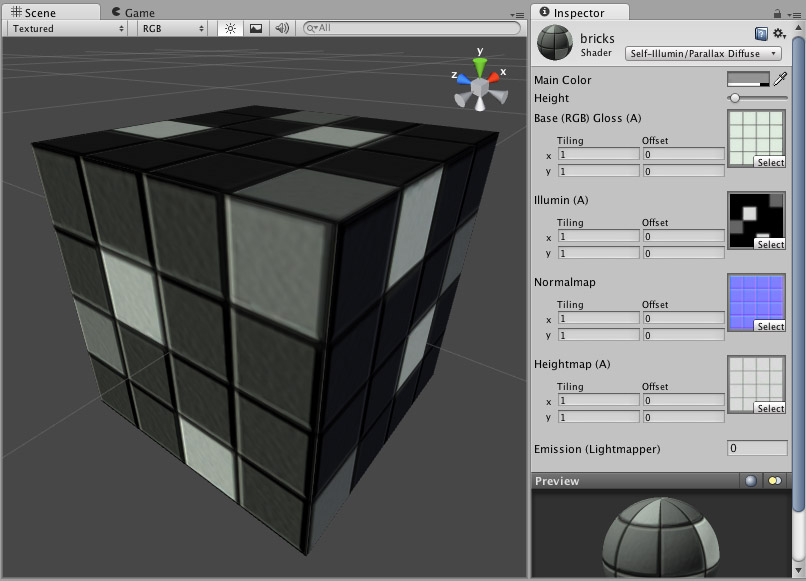Self-Illuminated Parallax Diffuse
Note. Unity 5 introduced the Standard ShaderA built-in shader for rendering real-world objects such as stone, wood, glass, plastic and metal. Supports a wide range of shader types and combinations. More info
See in Glossary which replaces this shaderA small script that contains the mathematical calculations and algorithms for calculating the Color of each pixel rendered, based on the lighting input and the Material configuration. More info
See in Glossary.

Self-Illuminated Properties
Note. Unity 5 introduced the Standard Shader which replaces this shader.
This shader allows you to define bright and dark parts of the object. The alpha channel of a secondary texture will define areas of the object that “emit” light by themselves, even when no light is shining on it. In the alpha channel, black is zero light, and white is full light emitted by the object. Any sceneA Scene contains the environments and menus of your game. Think of each unique Scene file as a unique level. In each Scene, you place your environments, obstacles, and decorations, essentially designing and building your game in pieces. More info
See in Glossary lights will add illumination on top of the shader’s illumination. So even if your object does not emit any light by itself, it will still be lit by lights in your scene.
Parallax Normal mapped Properties
Parallax Normal mapped is the same as regular Normal mapped, but with a better simulation of “depth”. The extra depth effect is achieved through the use of a Height Map. The Height Map is contained in the alpha channel of the Normal mapA type of Bump Map texture that allows you to add surface detail such as bumps, grooves, and scratches to a model which catch the light as if they are represented by real geometry. More info
See in Glossary. In the alpha, black is zero depth and white is full depth. This is most often used in bricks/stones to better display the cracks between them.
The Parallax mapping technique is pretty simple, so it can have artifacts and unusual effects. Specifically, very steep height transitions in the Height Map should be avoided. Adjusting the Height value in the InspectorA Unity window that displays information about the currently selected GameObject, asset or project settings, allowing you to inspect and edit the values. More info
See in Glossary can also cause the object to become distorted in an odd, unrealistic way. For this reason, it is recommended that you use gradual Height Map transitions or keep the Height slider toward the shallow end.
Diffuse Properties
Diffuse computes a simple (Lambertian) lighting model. The lighting on the surface decreases as the angle between it and the light decreases. The lighting depends only on this angle, and does not change as the cameraA component which creates an image of a particular viewpoint in your scene. The output is either drawn to the screen or captured as a texture. More info
See in Glossary moves or rotates around.
Performance
Generally, this shader is on the more expensive renderingThe process of drawing graphics to the screen (or to a render texture). By default, the main camera in Unity renders its view to the screen. More info
See in Glossary side. For more details, please view the Shader Peformance page.